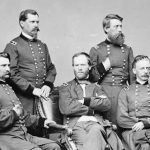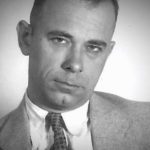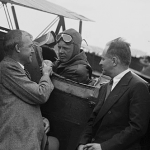 Music
Music  Music
Music  History
History 10 Less Than Jolly Events That Occurred on December 25
 Weird Stuff
Weird Stuff 10 Funny Ways That Researchers Overthink Christmas
 Politics
Politics 10 Political Scandals That Sent Crowds Into the Streets
 Weird Stuff
Weird Stuff Ten Bizarre Facts About The Doge Meme
 Our World
Our World 10 Ways Your Christmas Tree Is More Lit Than You Think
 Movies and TV
Movies and TV The 10 Coolest Stars to Set Sail on The Love Boat
 History
History 10 Things You Didn’t Know About the American National Anthem
 Technology
Technology Top 10 Everyday Tech Buzzwords That Hide a Darker Past
 Humans
Humans 10 Everyday Human Behaviors That Are Actually Survival Instincts
 Music
Music 10 Surprising Origin Stories of Your Favorite Holiday Songs
 History
History 10 Less Than Jolly Events That Occurred on December 25
 Weird Stuff
Weird Stuff 10 Funny Ways That Researchers Overthink Christmas
Who's Behind Listverse?

Jamie Frater
Head Editor
Jamie founded Listverse due to an insatiable desire to share fascinating, obscure, and bizarre facts. He has been a guest speaker on numerous national radio and television stations and is a five time published author.
More About Us Politics
Politics 10 Political Scandals That Sent Crowds Into the Streets
 Weird Stuff
Weird Stuff Ten Bizarre Facts About The Doge Meme
 Our World
Our World 10 Ways Your Christmas Tree Is More Lit Than You Think
 Movies and TV
Movies and TV The 10 Coolest Stars to Set Sail on The Love Boat
 History
History 10 Things You Didn’t Know About the American National Anthem
 Technology
Technology Top 10 Everyday Tech Buzzwords That Hide a Darker Past
 Humans
Humans 10 Everyday Human Behaviors That Are Actually Survival Instincts
10 Heroes of War Who Aren’t Famous for Fighting
When we think of heroes, particularly heroes of war, we often imagine a macho soldier clad in camo with honors bestowed on him for his heroics, a bullet belt over his shoulder, and a nice, sexy Hollywood battle scar to show he took a bullet for a friend. In an ideal world, these types of warriors wouldn’t be necessary.
But the unfortunate truth is war happens, and to win wars, you need more than battle-hardened soldiers. You need strategists and leaders who inspire; you need logistics and a medical team that can pull you through the worst type of injuries with nothing but a jolt of morphine and a few bandages. Some heroes of war are heroes without ever seeing the front lines.
Here are ten heroes of war that aren’t famous for fighting.
Related: Top 10 Weird And Wonderful Things From The World’s Militaries
10 The Navajo Code Talkers
Communication in war is of the utmost importance. Keeping instructions, tactics, and plans a secret can be the difference between losing a battle and victory, which is also the difference between men dying or surviving.
For this task, the Marine Corps thought it fit to select 29 Navajo men, a group of Native Americans who could speak both fluent English and Navajo. These men created a secret code language based on the unwritten Navajo language by assigning Navajo words to key phrases and military tactics. This enabled the Code Talkers to decode three lines of English in 20 seconds.
The first Type 1 code consisted of 26 Navajo terms, and the Type 2 contained 211 terms (which was later expanded to 411). Were it not for the Navajos, the Marines would not have been as successful. As Major Howard Connor stated the Marines “would not have taken Iwo Jima,” a key island in the war in the Pacific.[1]
9 Andreé de Jongh
Countess Andrée Eugénie Adrienne de Jongh was a Belgian resistance heroine born in 1916. Impressed by Edith Cavell, who was executed by the Germans for helping 200 soldiers escape from Belgium during WW1, she decided to become a nurse. While treating soldiers, she began to emulate her hero Cavell, a task more complicated than Cavell’s as the Netherlands and France had been overrun by the Nazis.
De Jongh appeared in a British consulate with a British soldier and requested support for her escape network, which was granted, and the Comet Line was birthed. The Comet Line went from Brussels to the Pyrenees through France, all the way to Gibraltar and the British consulate in Madrid. The escape route aided in the rescue of some 400 soldiers, 118 of whom de Jongh accompanied herself.
She was eventually captured, spending the final years of WWII in a Nazi concentration camp. She died at the ripe old age of 90.[2]
8 The Monuments Men
Throughout WWII, the Nazis collected (stole) art as they annexed territories, plundering museums and churches across Europe. In response, the U.S. created what is known as the Monuments, Fine Arts, and Archives section of the military, also famous as the Monuments Men.
In 1944, Walker Hancock and the five Monuments Men left their lives in the arts and their families to track down six million pieces of art in the hopes of restoring them to their rightful place in cultural history.
The team scoured storage units, bunkers, personal homes, and bases used by the Nazi command to retrieve the art. But nowhere did they recover more treasures than at the ancient salt mine at Altaussee in the Austrian Alps.
In a race against time, and the very real possibility that the mines might be sealed by explosives or the art might be raided by the Soviets, the Monuments Men documented and ultimately rescued thousands of works of art, from paintings and drawings to sculptures and armor.[3]
7 John Rabe
Also known as the living Buddha of Nanking, Rabe was a German businessman and leader of the Nazi party in Nanking, China. When the Japanese army advanced, Rabe and his countrymen were advised to depart. But he chose to stay, not able to leave his employees and friends behind, citing that Nanking was his home.
After interrogation by the Japanese army, Rabe set out to create a Safety Zone, a neutral area where no fighting might occur. The Japanese were not interested in his proposal, so Rabe did what any good Nazi would—he contacted Hitler himself. With Japan forming part of the Axis powers, Japan agreed to Germany’s terms, saving thousands in the process.
The city fell to the Japanese, and although he could not prevent the numerous atrocities that wreaked havoc on the citizens, Rabe did what he could to contain the violence, saving many more.[4]
6 The Ghost Army
Officially the first mobile deception unit in U.S. history, the 23rd Headquarters Special Troops consisted of 82 officers and 1,023 units under the command of Colonel Harry. L Reeder. Their aim was to fool the German army by way of state-of-the-art visual, sonic, and radio deception techniques.
The Ghost Army carried out more than 20 operations of deception during the final year of the war by using artistic talents and tech savvy to create inflatable tanks and artillery, speakers that boomed pre-recorded troops, and fake radio dispatches to confuse and ultimately defeat the enemy.
It is estimated that around 15,000–30,000 lives were saved by the antics of the 23rd.[5]
5 Raoul Wallenberg
Raoul Wallenberg was a Swedish businessman and diplomat who became known for his incredible efforts to save Hungarian Jews from prosecution. After convincing the Swedish Foreign Ministry to send him to Budapest with a diplomatic passport, his work began.
Wallenberg began providing certificates of protection to the Jewish populace facing deportation to Auschwitz and established hospitals, nurseries, and a soup kitchen. He also made it possible for 30 safe houses to be established and reserved for Jewish families with certificates of protection issued by a neutral country.
After the Soviets liberated Budapest, an estimated 100,000 Jews remained in the city, mostly due to the efforts of Wallenberg and his colleagues.[6]
4 Desmond Doss
Facing ridicule from his squad for his so-called “conscientious objector” status (against violence), Desmond ultimately followed the men to war in the Pacific without a gun. It was his calling to save as many of his friends as he could, and that was exactly what he did.
After proving his worth in battles before, it was at the Maeda Escarpment, or what the allies referred to as Hacksaw Ridge, that he earned his Medal of Honor for outstanding service.
After the Americans claimed the cliff they fought over for bloody days on end, a sudden vicious counter-attack forced the men into retreat. Less than a third of the men made it back.
After defying orders, Doss rushed back to rescue the wounded, ultimately saving the lives of at least 75 men. He was severely wounded days later, and that was the end of his war. For his heroics, he was awarded a myriad of awards for valor and courage.[7]
3 Virginia Hall
Virginia Hall was one of the most highly decorated American spies ever, and until recently, nobody knew about her or her antics. Hall, born in the U.S. to wealthy parents, was always on the lookout for adventure. She traveled to Paris to study, and there she fell in love with France. After landing a clerical job, she lost her foot in an unfortunate shooting accident, and she decided that her life needed something more. After Germany invaded France, she was forced from her home and drawn into the world of espionage.
From then on, she organized a local resistance against the occupiers and communicated intelligence to the British Security Service with little hope of survival. In a time when it was forbidden for women to be on the frontline, she held firm in her resistance, earning her the nickname the “Limping Lady of Lyon.”
One of her more important feats was the rescue of 12 men from a prison camp, now known as the Mauzac Escape, with her processes even influencing how the Americans approached their campaign in Afghanistan in recent times.[8]
2 Freddie and Truus Oversteegen
One could argue that the Oversteegens fought for as long as the war lasted, but theirs was more of a backhand to the Nazi sympathizers and allies. Together, they distributed the Trouw, a banned publication at the time, and took part in an underground resistance against the Nazi occupation of the Dutch people.
Along with their friend Hannie Schaft, the three became their own squad, executing drive-by shootings from their bicycles and seducing soldiers from bars to nearby woods where they would have them executed by other resistance fighters (killing some themselves). Quite remarkably, they even managed to shelter political dissents, gay people, and Jews from the Nazi occupiers.
Both Freddie and Truus lived into their 90s. Unfortunately, Schaft was captured and executed 18 days before the liberation of the Netherlands.[9]
1 William Martin
Although William Martin never existed, the deception of his existence was part of Operation Mincemeat, one of the greatest ruses in military history. The secret mission required the British Army to fake death with a real unidentified corpse taken from the morgue and create an entire identity and backstory. They manufactured his whole existence, from wedding photos to theater stubs, and then dropped his body in the ocean off the coast of Spain in the hopes that his remains would be discovered.
On Martin’s body, there was also a briefcase with top secret documents suggesting the Allies would invade Sardinia. However, that was never the plan. Knowing full well there were Nazi sympathizers among the Spanish ranks, the British army managed to deceive the German army, with Nazi troops being sent to Greece and the Balkans in response, leaving Sicily open for an easy assault.
William Martin was the non-existent man who changed the course of WWII.[10]








